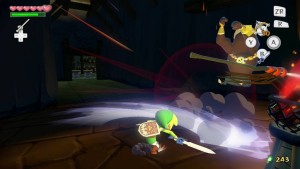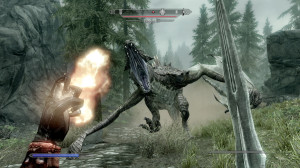Back again, wandering readers, and this time with substantially less mucus! Yes, my allergies have been backing off as the Spring season warms into the Summer months, but enough about the air and its effects on my nasal passages. People come here for my ideas on the industry, sundry and opinionated as they may be, and damn it if I will not deliver once again! So, the topic this week is one I am a bit surprised I have not touched on in any of the roughly ninety posts I have constructed here at Lcom. That topic is “gamefeel” and exactly what that term implies and its role in evaluating a game. It may not be the most well known term in the gaming community, but it gets flung around often enough in reviews or in casual appraisals about game design and critique about gameplay.
Gamefeel, as I have chosen to style it as one word although I have seen it as two words, is just nebulous enough that it can be used in any number of situations without pressing need for clarification thanks to context, and yet that does not mean it should be without some defining. Gamefeel is the sum impression of a game’s mechanical and visual feedback during combat, moving around, browsing menus, indeed during most aspects of gameplay. To say a game has good gamefeel is to say the game is satisfying beyond just a serviceable ability to accomplish desired tasks. When a game has poor or inconsistent gamefeel is when readers will see words like “janky” thrown around, which is another nebulous catch-all term clarified through context. Jankiness, or sometimes “jank”, is essentially a lack of good gamefeel that imparts something upon the player without necessarily getting in the way. Plenty of very commercially successful and critically praised games have also been labeled as janky, much to the befuddlement of some critics and sometimes myself.
My prime example of a successful and fun game that was also saddled with poor gamefeel is The Elder Scrolls V: Skyrim. I, along with many others, played this game obsessively when it was new and enjoyed the expansive world and lore that for the first time seemed to be bigger than my appetite. And while I marveled at the volume of content before me, I was also putting up with a considerable amount of jankiness. The first person perspective melee combat (something I have griped about before) and that classic Bethesda sluggishness of movement all contributed to a game that gets the job done, but is not thrilling in the process. Landing a blow with a sword or deflecting an incoming attack is often enough a hope and not a certainty to the point that it distances the player from feeling completely plugged into the on-screen experience.
The same conversations are being had in some circles about the newly released and hotly anticipated The Witcher 3: Wild Hunt, which many proclaim provides a wide open world and rich lore but less than satisfying combat. And given that Wild Hunt is the next major release that followed the equally anticipated Bloodborne, the comparisons between the two were invariably drawn, which brings my topic nicely into focus. A game like Bloodborne is of medium-long length, likely taking the average player about forty or fifty hours to complete, whereas Wild Hunt comes packed with one of the largest game worlds ever created. If Skyrim is any indication then, if I were to try my hand at the game, playtimes would reach well over one hundred hours for many players with plenty of things still left undone. So the understanding can be had when a more tightly produced game like Bloodborne offers better gamefeel than Wild Hunt which has a lot more on its plate to take care of aside from combat mechanics.
A game like Wild Hunt seems to fall victim to inconsistent degrees of control afforded to the player where actions, like directing the horse, do not predictably occur. Feedback is another major part of gamefeel wherein a player’s actions give some degree of visual or audio cue to help simulate the feeling of really taking part in the on-screen events. The tricks of the trade for creating that feedback are many, and when it does not work or is absent the experience can often feel muted or uninteresting. The Legend of Zelda: The Wind Waker gives feedback by including dramatic musical accompaniment to every strike Link lands. This game and many other will also stutter or pause the action for a split second to give an added feeling of weight and impact, likewise the enemies can have varied reactions to being struck. It all allows the simple action of swinging a weapon around be better communicated to a person sitting on a couch only moving their thumbs, much like actors on stage will wear copious amounts of makeup to help exaggerate their emotions and gestures to an audience that is physically far-removed from their presence — games accentuate themselves to make up for their inherent shortcomings.
But as Wild Hunt and others prove, and will continue to prove, gamefeel is not completely necessary for a game to succeed commercially and critically. Because weak gamefeel is not the same as weak gameplay in several subtle ways, a game like Skyrim can still be an immersive and compelling place in which to spend hundreds of hours. Games like this are examples of being more than the sum of their parts, where the story and the atmosphere or the progression systems and loot hunts or any number of other mechanics help make up for weaker gamefeel. Despite this, I will generally prefer a game that focuses on responsiveness over quantity of content or even beauty of that content because gamefeel is ultimately provides the overriding experience. The moments spent appreciating an environment, enjoying backstory or dialogue all shrink compared to the amount of time spent interfacing with the game. And while I can still manage a good time from games like Skyrim, I do not think it is my duty to find the fun in a premium product that functions solely to be fun. The failure (or lack of execution, if one prefers) might be compensated for but so can a missing limb. Life can still be enjoyed without it, but I think few honest people would claim it as ideal. And when a product is purposely designed as entertainment, with time and money set aside for the planning of it, then it should be a fair criticism to judge a company’s ability to produce the ideal.
Now let me know about your thoughts on this term. Have you ever heard or seen it before? If so, does your interpretation differ from mine or do my examples seen unfit? Ah, who am I kidding? I NEVER draw poor comparisons in my articles! NEVER!


